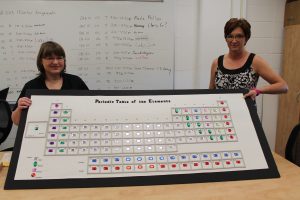What do you get when a student who is a lab assistant to a visually impaired person starts talking to a professor who is all about accessibility? You get a tactile periodic table, complete with three-dimensional “jewels” to designate the elements’ properties.
In spring 2012, Katie Jenkins ’12 was enrolled in Dr. Shauna Hiley’s Chemistry Teaching: Methods and
Techniques class while also serving as a personal assistant to a visually impaired student in a biology lab. Jenkins and Dr. Hiley, professor of chemistry, decided to work together over the summer to create a tactile periodic table.
“We both learned a lot beyond the construction of it,” said Dr. Hiley. “It really hit home the importance of universal design (accessible to all, not just people with disabilities).” By keeping that in mind, she said, the tactile periodic table is helpful to sighted students, as well.
The periodic table, which Dr. Hiley calls “the most important tool in chemistry to explain the physical and chemical properties of elements,” used four different shapes of jewels and different colors to denote metals, metalloids, nonmetals and noble gases. (Hydrogen stands alone with a heart-shaped jewel.) Sighted students can easily spot the groupings and the reasoning behind them because of the jewels.
Additionally, each element shape is listed with its atomic number and name in Braille, which was printed by Missouri Western’s Adaptive Technology Services.
“One of the positives of working on this project and as a personal assistant was that I had to learn to be a better auditory communicator, and I really had to listen,” said Jenkins, who teaches at Mid-Buchanan High School. “The whole process made me a better teacher.”
The pair also created an Aufbau board to help students understand the Aufbau principle of how electrons move to energy levels.
“The idea is to come up with creative solutions to bring science to everyone,” Dr. Hiley said. “We ignored the disability and focused on accessibility.”

